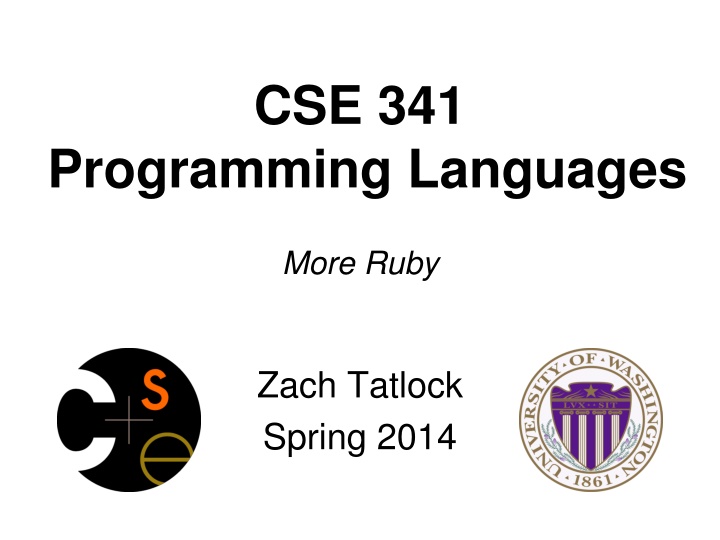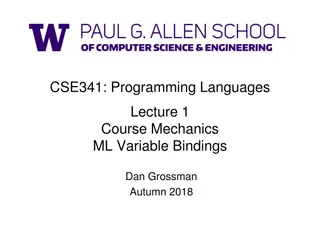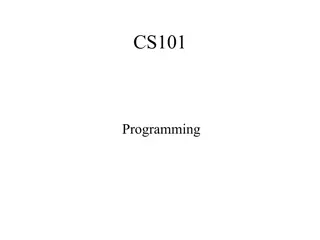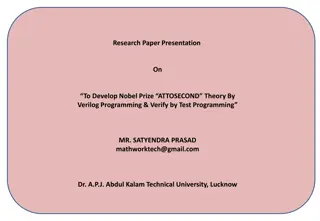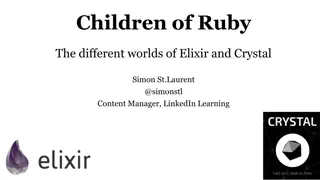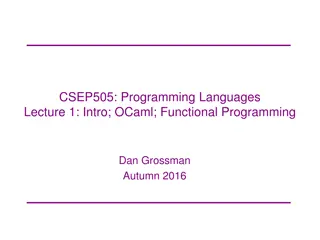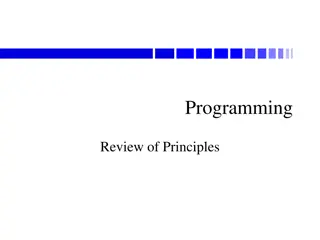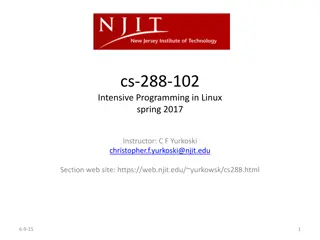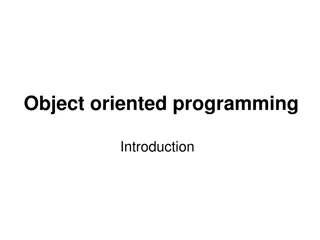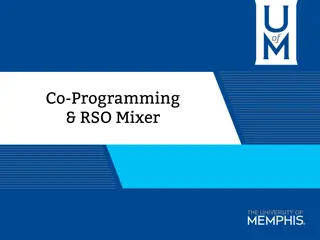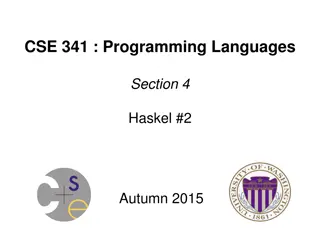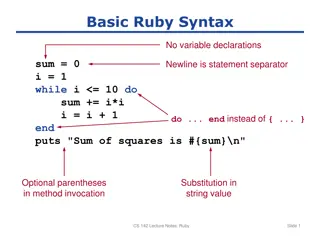Ruby Programming Topics and Features
This content delves into various Ruby programming topics and features, covering flexible arrays, ranges, hashes, closures, arrays manipulation, and blocks. It discusses Ruby's approach to almost-closures and closures, arrays syntax and methods, and the usage of blocks in Ruby, including passing blocks with messages. The content emphasizes the dynamic nature of Ruby, its extensive standard library, and the prevalence of method iterators over explicit loops. Examples and considerations for working with arrays and blocks are provided, highlighting Ruby's unique features and syntax.
Download Presentation

Please find below an Image/Link to download the presentation.
The content on the website is provided AS IS for your information and personal use only. It may not be sold, licensed, or shared on other websites without obtaining consent from the author.If you encounter any issues during the download, it is possible that the publisher has removed the file from their server.
You are allowed to download the files provided on this website for personal or commercial use, subject to the condition that they are used lawfully. All files are the property of their respective owners.
The content on the website is provided AS IS for your information and personal use only. It may not be sold, licensed, or shared on other websites without obtaining consent from the author.
E N D
Presentation Transcript
CSE 341 Programming Languages More Ruby Zach Tatlock Spring 2014
This lecture Three mostly separate topics Flexible arrays, ranges, and hashes [actually covered in section] Ruby s approach to almost-closures (blocks) and closures (Procs) [partially discussed in section as well] Convenient to use; unusual approach Used throughout large standard library Explicit loops rare Instead of a loop, go find a useful iterator Subclasses, inheritance, and overriding The essence of OOP, now in a more dynamic language 2
Ruby Arrays Lots of special syntax and many provided methods for the Array class Can hold any number of other objects, indexed by number Get via a[i] Set via a[i] = e Compared to arrays in many other languages More flexible and dynamic Fewer operations are errors Less efficient The standard collection (like lists were in ML and Racket) 3
Using Arrays See many examples, some demonstrated here Consult the documentation/tutorials If seems sensible and general, probably a method for it Arrays make good tuples, lists, stacks, queues, sets, Iterating over arrays typically done with methods taking blocks Next topic 4
Blocks Blocks are probably Ruby's strangest feature compared to other PLs But almost just closures Normal: easy way to pass anonymous functions to methods for all the usual reasons Normal: Blocks can take 0 or more arguments Normal: Blocks use lexical scope: block body uses environment where block was defined Examples: 3.times { puts "hi" } [4,6,8].each { puts "hi" } i = 7 [4,6,8].each {|x| if i > x then puts (x+1) end } 5
Some strange things Can pass 0 or 1 block with any message Callee might ignore it Callee might give an error if you do not send one Callee might do different things if you do/don t send one Also number-of-block-arguments can matter Just put the block next to the other arguments (if any) Syntax: {e},{|x| e}, {|x,y| e}, etc. (plus variations) Can also replace { and } with do and end Often preferred for blocks > 1 line 6
Blocks everywhere Rampant use of great block-taking methods in standard libraray Ruby has loops but very rarely used Can write (0..i).each {|j| e}, but often better options Examples (consult documentation for many more) a = Array.new(5) {|i| 4*(i+1)} a.each { puts "hi" } a.each {|x| puts (x * 2) } a.map {|x| x * 2 } #synonym: collect a.any? {|x| x > 7 } a.all? {|x| x > 7 } a.inject(0) {|acc,elt| acc+elt } a.select {|x| x > 7 } #non-synonym: filter 7
More strangeness Callee does not give a name to the (potential) block argument Instead, just calls it with yield or yield(args) Silly example: def silly a (yield a) + (yield 42) end x.silly 5 { |b| b*2 } See code for slightly less silly example Can ask block_given? but often just assume a block is given or that a block's presence is implied by other arguments 8
Blocks are second-class All a method can do with a block is yield to it Cannot return it, store it in an object (e.g., for a callback), But can also turn blocks into real closures Closures are instances of class Proc Called with method call This is Ruby, so there are several ways to make Proc objects One way: method lambda of Object takes a block and returns the corresponding Proc 9
Example a = [3,5,7,9] Blocks are fine for applying to array elements b = a.map {|x| x+1 } i = b.count {|x| x>=6 } But for an array of closures, need Proc objects More common use is callbacks c = a.map {|x| lambda {|y| x>=y}} c[2].call 17 j = c.count {|x| x.call(5) } 10
Moral First-class ( can be passed/stored anywhere ) makes closures more powerful than blocks But blocks are (a little) more convenient and cover most uses This helps us understand what first-class means Language design question: When is convenience worth making something less general and powerful? 11
More collections Hashes like arrays but: Keys can be anything; strings and symbols common No natural ordering like numeric indices Different syntax to make them Like a dynamic record with anything for field names Often pass a hash rather than many arguments Ranges like arrays of contiguous numbers but: More efficiently represented, so large ranges fine Good style to: Use ranges when you can Use hashes when non-numeric keys better represent data 12
Similar methods Arrays, hashes, and ranges all have some methods other don t E.g., keys and values But also have many of the same methods, particularly iterators Great for duck typing Example def foo a a.count {|x| x*x < 50} end foo [3,5,7,9] foo (3..9) Once again separating how to iterate from what to do 13
Next major topic Subclasses, inheritance, and overriding The essence of OOP Not unlike you have seen in Java, but worth studying from PL perspective and in a more dynamic language 14
Subclassing A class definition has a superclass (Object if not specified) class ColorPoint < Point The superclass affects the class definition: Class inherits all method definitions from superclass But class can override method definitions as desired Unlike Java/C#/C++: No such thing as inheriting fields since all objects create instance variables by assigning to them Subclassing has nothing to do with a (non-existent) type system: can still (try to) call any method on any object 15
Example (to be continued) class Point attr_accessor :x, :y def initialize(x,y) @x = x @y = y end def distFromOrigin # direct field access Math.sqrt(@x*@x end def distFromOrigin2 # use getters Math.sqrt(x*x end end class ColorPoint < Point attr_accessor :color def initialize(x,y,c) super(x,y) @color = c end end + @y*@y) + y*y) 16
An object has a class p = Point.new(0,0) cp = ColorPoint.new(0,0,"red") p.class # Point p.class.superclass # Object cp.class # ColorPoint cp.class.superclass # Point cp.class.superclass.superclass # Object cp.is_a? Point # true cp.instance_of? Point # false cp.is_a? ColorPoint # true cp.instance_of? ColorPoint # true Using these methods is usually non-OOP style Disallows other things that "act like a duck" Nonetheless semantics is that an instance of ColorPoint is a Pointbut is not an instance of Point [ Java note: instanceof is like Ruby's is_a? ] 17
Example continued Consider alternatives to: class ColorPoint < Point attr_accessor :color def initialize(x,y,c) super(x,y) @color = c end end Here subclassing is a good choice, but programmers often overuse subclassing in OOP languages 18
Why subclass Instead of creating ColorPoint, could add methods to Point That could mess up other users and subclassers of Point class Point attr_accessor :color def initialize(x,y,c="clear") @x = x @y = y @color = c end end 19
Why subclass Instead of subclassing Point, could copy/paste the methods Means the same thing if you don't use methods like is_a? and superclass, but of course code reuse is nice class ColorPoint attr_accessor :x, :y, :color def initialize(x,y,c="clear") end def distFromOrigin Math.sqrt(@x*@x + @y*@y) end def distFromOrigin2 Math.sqrt(x*x + y*y) end end 20
Why subclass Instead of subclassing Point, could use a Point instance variable Define methods to send same message to the Point Often OOP programmers overuse subclassing But for ColorPoint, subclassing makes sense: less work and can use a ColorPoint wherever code expects a Point class ColorPoint attr_accessor :color def initialize(x,y,c="clear") @pt = Point.new(x,y) @color = c end def x @pt.x end # similar forwarding methods # for y, x=, y= end 21
Overriding ThreeDPoint is more interesting than ColorPoint because it overrides distFromOrigin and distFromOrigin2 Gets code reuse, but highly disputable if it is appropriate to say a ThreeDPoint is a Point Still just avoiding copy/paste class ThreeDPoint < Point def initialize(x,y,z) super(x,y) @z = z end def distFromOrigin # distFromOrigin2 similar d = super Math.sqrt(d*d + @z*@z) end end 22
So far With examples so far, objects are not so different from closures Multiple methods rather than just call me Explicit instance variables rather than environment where function is defined Inheritance avoids helper functions or code copying Simple overriding just replaces methods But there is one big difference: Overriding can make a method defined in the superclass call a method in the subclass The essential difference of OOP, studied carefully next lecture 23
Example: Equivalent except constructor Also need to define x= and y= (see code file) class PolarPoint < Point def initialize(r,theta) @r = r @theta = theta end def x @r * Math.cos(@theta) end def y @r * Math.sin(@theta) end def distFromOrigin @r end end Key punchline: distFromOrigin2, defined in Point, already works def distFromOrigin2 Math.sqrt(x*x+y*y) end Why: calls to self are resolved in terms of the object's class 24
